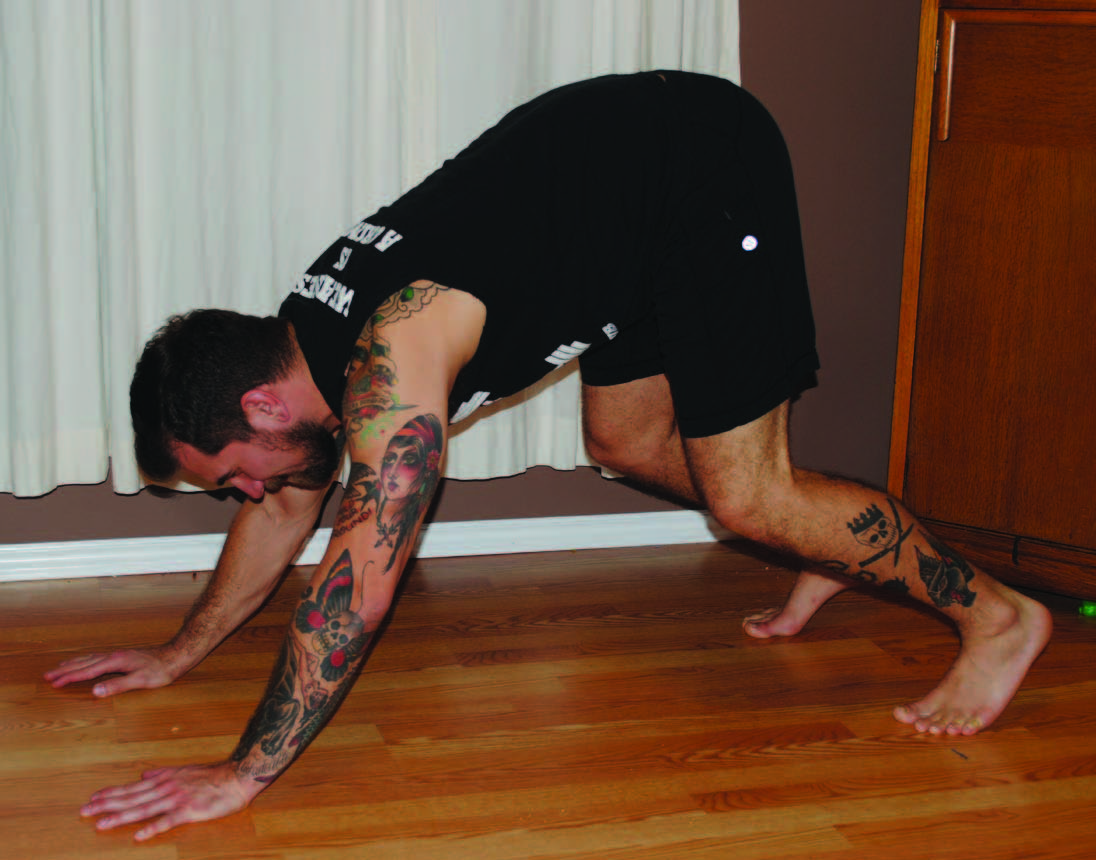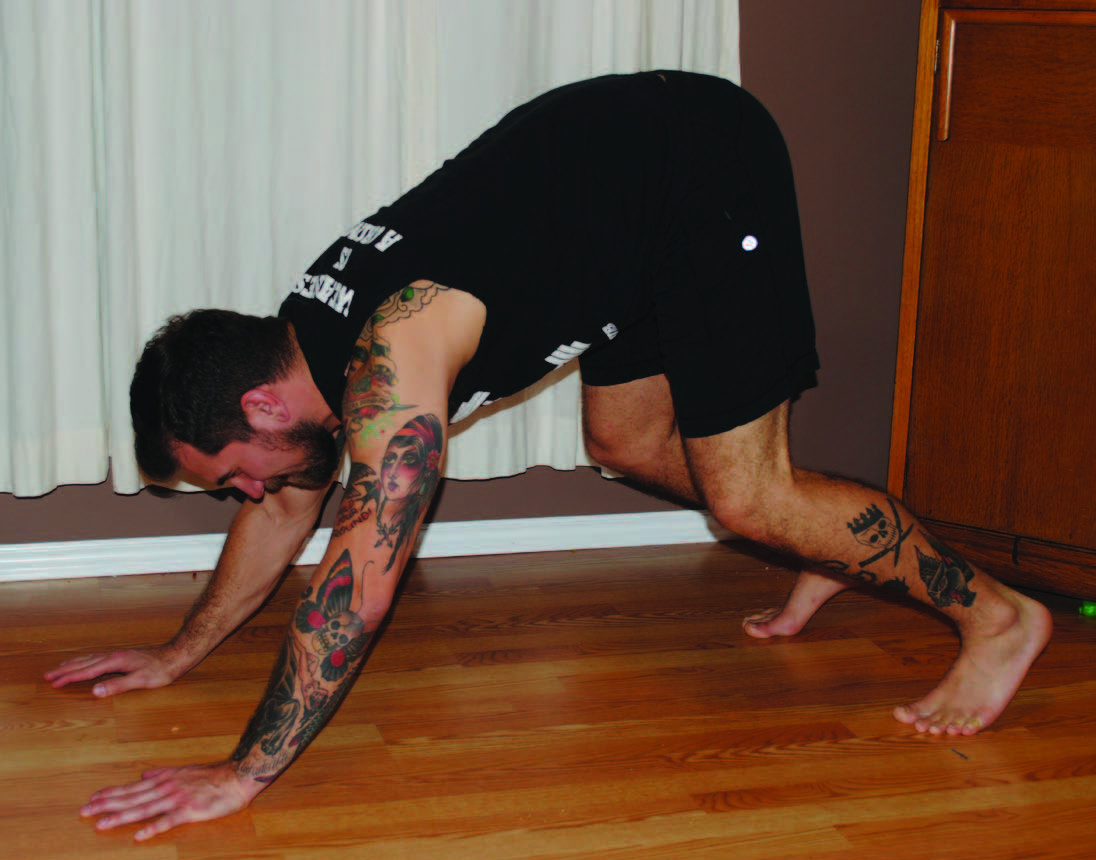Be an Animal

Paleo, caveman training, barefoot running...everybody these days is trying to reverse evolution and return to our "primal" roots. I won't sit here and wax philosophical on the nature of the fitness industry and its tendency to constantly progress and react, but I will talk about what we can learn from this "re-wilding" of fitness.
Unleash the Beast!
Being an animal doesn't have to refer to releasing some sort of savage inner monster, or becoming some sort of hyper-aggressive killer--unless that's your bag, and then I say more power to you! But what if we instead took these notions of animalistic behavior and applied them to our workouts in the form of playful intensity? Instead of endless sprints and prowler pushes (which have their value, for sure), let's start moving in different ways - as the title suggests, like an animal.
Animal movements force us to move in different ways, taxing our nervous system and giving us the opportunity to use muscle groups synergistically in ways we might not normally.
My favorite to teach right off the bat is the bear crawl. Simple, but not easy, it helps us rediscover our relationship with the ground, move in all directions and use our hips and shoulders together - something we don't often do, especially in a complex, multi-planar movement like the bear crawl. To execute the movement, all you have to do is get down on all fours, equally distribute your weight between your hands and feet and move! Think springy, light on your hands and feet, and moving as fluidly as possible in all directions. Try forward, back, and side to side. Maybe even hop, if you're feeling confident. For some, this is extremely award and even disorienting in the beginning. Once you've mastered the basic bear crawl, try reverse bear crawls for a real shoulder burn. And try keeping the hips low for a modified bear crawl that I call the "panther crawl," a move that requires a bit more coordination and hip mobility.

Next is the frog hop, which is similar to the bear crawl, but with the hips much lower and an explosive component in the hop. Begin in a very low squat. Don't worry if your back rounds; we're not loading the spine. Keeping your feet flat on the ground, reach your hand out in front of you and jump your feet to outside your hands. If you have inflexible hips, this will be quite challenging at first. I can't recommend this movement enough for helping train squat depth.
Turn the frog hop position sideways and you have the gorilla: a fun, adaptable move that opens the hips and teaches lateral movement and coordination. Begin in the low squat position, reach the hands out to the side, shift the weight onto the hands as you hop the legs sideways in the same direction. This move can be done quickly, or slowly for a great challenge. One of our favorite variations is the "ninja gorilla" wherein you execute the move as slow as possible and drive the hips up as high as possible in the middle of the movement (when your weight is on your hands). This is good training for cartwheels, and we use it all the time to get people who have never cartwheeled in their lives to experience the movement.
The third movement we'll discuss from the low squat position is the duck walk. Sit as low as possible in an upright squat position (hands off the ground) and walk forward, maintaining as low a squat position as possible throughout the entire movement. For an added challenge, try "prison duck" where you perform the movement with your hands interlaced behind your head. And for even more fun, replace the walk with a hop - still staying low throughout the entire movement, but hopping forward.
A great mobility animal move is the inchworm: begin in a plank (push-up) position, slowly walk the feet up towards the hands, maintaining straight legs the entire time. If you have inflexible hamstrings/calves, you probably won't be able to get your feet very close to your hands without bending the knees. Only step the feet up as far as you can without significantly bending your knees. Once you've reached that point, begin walking your hands back out to the push-up position. This movement can be performed with or without a push-up. Once you've mastered the slow motion inchworm, try hopping the feet up and jumping the hands back out to the push-up position - make sure to keep those legs straight, though, as the dynamic version can easily lead to bent knees.
Putting it all together
There's a ton more, but these options are a great start. The question now is, "how do I use this stuff?" The great thing about animal movements is that they're easily thrown into any GPP workout and add tons of mobility and intensity. You can bookend an animal crawl with movements (ie: 10 burpees, bear crawl 5 windmills, reverse bear crawl back) or do a distance-based workout (such as 100 feet each of various movements, such as: farmer's walk, broad jump, overhead walk, panther - breaking up each movement as needed).
Use these movements freely and playfully. One major hang-up people seem to have with animal movements is overthinking - the inability to just let go and move! The only rule is if it hurts, don't do it! Since a majority of our training is highly structured and predominately sagittal plane, adding in multi-planar movements like animal moves isn't just fun, but beneficial as well. Hopefully you're inspired to try out some of these moves and release your inner animal!
Unleash the Beast!
Being an animal doesn't have to refer to releasing some sort of savage inner monster, or becoming some sort of hyper-aggressive killer--unless that's your bag, and then I say more power to you! But what if we instead took these notions of animalistic behavior and applied them to our workouts in the form of playful intensity? Instead of endless sprints and prowler pushes (which have their value, for sure), let's start moving in different ways - as the title suggests, like an animal.
Animal movements force us to move in different ways, taxing our nervous system and giving us the opportunity to use muscle groups synergistically in ways we might not normally.
My favorite to teach right off the bat is the bear crawl. Simple, but not easy, it helps us rediscover our relationship with the ground, move in all directions and use our hips and shoulders together - something we don't often do, especially in a complex, multi-planar movement like the bear crawl. To execute the movement, all you have to do is get down on all fours, equally distribute your weight between your hands and feet and move! Think springy, light on your hands and feet, and moving as fluidly as possible in all directions. Try forward, back, and side to side. Maybe even hop, if you're feeling confident. For some, this is extremely award and even disorienting in the beginning. Once you've mastered the basic bear crawl, try reverse bear crawls for a real shoulder burn. And try keeping the hips low for a modified bear crawl that I call the "panther crawl," a move that requires a bit more coordination and hip mobility.

Next is the frog hop, which is similar to the bear crawl, but with the hips much lower and an explosive component in the hop. Begin in a very low squat. Don't worry if your back rounds; we're not loading the spine. Keeping your feet flat on the ground, reach your hand out in front of you and jump your feet to outside your hands. If you have inflexible hips, this will be quite challenging at first. I can't recommend this movement enough for helping train squat depth.
Turn the frog hop position sideways and you have the gorilla: a fun, adaptable move that opens the hips and teaches lateral movement and coordination. Begin in the low squat position, reach the hands out to the side, shift the weight onto the hands as you hop the legs sideways in the same direction. This move can be done quickly, or slowly for a great challenge. One of our favorite variations is the "ninja gorilla" wherein you execute the move as slow as possible and drive the hips up as high as possible in the middle of the movement (when your weight is on your hands). This is good training for cartwheels, and we use it all the time to get people who have never cartwheeled in their lives to experience the movement.
The third movement we'll discuss from the low squat position is the duck walk. Sit as low as possible in an upright squat position (hands off the ground) and walk forward, maintaining as low a squat position as possible throughout the entire movement. For an added challenge, try "prison duck" where you perform the movement with your hands interlaced behind your head. And for even more fun, replace the walk with a hop - still staying low throughout the entire movement, but hopping forward.
A great mobility animal move is the inchworm: begin in a plank (push-up) position, slowly walk the feet up towards the hands, maintaining straight legs the entire time. If you have inflexible hamstrings/calves, you probably won't be able to get your feet very close to your hands without bending the knees. Only step the feet up as far as you can without significantly bending your knees. Once you've reached that point, begin walking your hands back out to the push-up position. This movement can be performed with or without a push-up. Once you've mastered the slow motion inchworm, try hopping the feet up and jumping the hands back out to the push-up position - make sure to keep those legs straight, though, as the dynamic version can easily lead to bent knees.
Putting it all together
There's a ton more, but these options are a great start. The question now is, "how do I use this stuff?" The great thing about animal movements is that they're easily thrown into any GPP workout and add tons of mobility and intensity. You can bookend an animal crawl with movements (ie: 10 burpees, bear crawl 5 windmills, reverse bear crawl back) or do a distance-based workout (such as 100 feet each of various movements, such as: farmer's walk, broad jump, overhead walk, panther - breaking up each movement as needed).
Use these movements freely and playfully. One major hang-up people seem to have with animal movements is overthinking - the inability to just let go and move! The only rule is if it hurts, don't do it! Since a majority of our training is highly structured and predominately sagittal plane, adding in multi-planar movements like animal moves isn't just fun, but beneficial as well. Hopefully you're inspired to try out some of these moves and release your inner animal!
|
Tyler Welch currently lives and teaches at Rock Jungle Fitness in Edmonton, AB. A bit of a fitness nomad, he's lived here and there, and studied a bit of this and that. He has more certifications and associations with more organizations that he might like to admit, but he has a deep and abiding love for strongman/woman work, Olympic weightlifting, powerlifting and weird bodyweight movements. You can find him online at secondnaturefitness.tumblr.com, though his wife and daughter don't give him enough free time to update as much as he probably should. |
Search Articles
Article Categories
Sort by Author
Sort by Issue & Date
Article Categories
Sort by Author
Sort by Issue & Date

